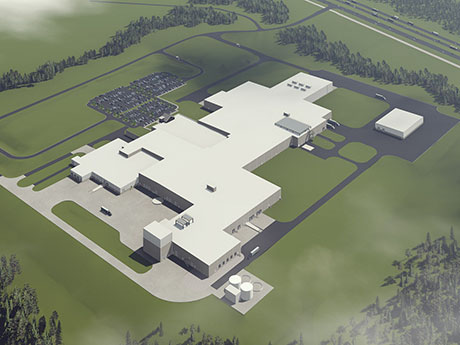By Mary Lamie, Bi-State Development, St. Louis Regional Freightway
The St. Louis regional industrial market continues to be a magnet for investment, with significant capital investment dollars flowing into four target industry sectors that remain key drivers of the bi-state economy. These sectors include metals, advanced manufacturing, food and AgTech, and chemicals. They are legacy industry sectors poised for continued innovation, job creation and economic diversification, in part due to the region’s exceptional logistics and transportation assets and established talent pipelines.
Metals
The St. Louis metropolitan area ranks second in the United States for mineral and ore exports. With more than $2.9 billion exported in 2022, the figures prove the market is well established for metals manufacturing, processing and shipping. The metals market is expected to grow with nearly 17,000 metals industry workers already in the region, and with copper supplier Wieland making a $500 million investment at its East Alton, Illinois, facility — a move that will retain 800 jobs in the region.

Bi-State Development, St. Louis Regional Freightway
“Wieland is committed to a sustainable future and is taking significant steps to modernize its East Alton facility,” says Greg Keown, president of Wieland Rolled Products North America. “This effort solidifies our ability to supply the advanced energy sectors and underscores our dedication to environmental responsibility and innovation.”
Advanced manufacturing
The St. Louis region is home to four times the number of aerospace manufacturing employees than similar-sized markets. Boeing recently announced $2 billion in new investment at its facilities in the area that will generate 650 new jobs, while Gulfstream Aerospace Corp.’s $28.5 million expansion at St. Louis Downtown Airport is creating 200 new jobs. Nearby, West Star Aviation’s expansion at St. Louis Regional Airport in East Alton, Illinois, will add 100 jobs, further elevating the region’s aerospace industry.
Other subsectors are also seeing significant investment, sparking a 9.6 percent net increase in advanced manufacturing jobs over the past decade. General Motors’ recent $1.5 billion expansion supported the retention of 4,100 jobs and further highlights the region’s manufacturing strength.
Food and AgTech
With more than 50 percent of all U.S. crops produced within a 500-mile radius of St. Louis, the region is a hub for food and AgTech research and manufacturing. More than 400 biotech research and development companies call the region home, and that number should grow following $87 million in National Institute of Health startup grants and $142 million of appropriated federal commercialization grants. Private companies are also investing, with American Foods Group building a new $800 million beef processing facility — America’s Heartland Packing — in Warren County, Missouri, and Tyson Food’s $180 million expansion in Caseyville, Illinois.
Upon completion in early 2025, America’s Heartland Packing will employ 1,300 workers with an attractive compensation package, and the overall regional impact of the “greenfield” build is estimated at $1 billion.
“We eventually narrowed our site search down to 25, then 10, then three sites, and eventually landed on Warren County,” says Scott Willert, CTP, president of America’s Service Line LLC/America’s Logistics. “We just felt that the infrastructure, natural resources, workforce, cattle inventory and I-70 played nice contributing factors to that selection. We’re excited about the location. It’s really at the crossroads of the U.S.”
Chemicals
The chemical sector in the St. Louis region is diverse, including chemical manufacturing and transportation, and industry-leading bioscience research and development, including biochemical companies. Regional bioscience and biochemical companies have received $1.5 billion in venture capital funding since 2015. The region also has more than three times more soap and cleaning compound manufacturing jobs than other similar-sized markets and has seen 12.3 percent growth in the industry’s jobs over the past five years, supported by major employers, such as Dial/Henkel and Procter & Gamble.
The St. Louis region is ranked among the top 25 metro areas in the U.S. for chemical exports. Nearly 16,000 chemical industry workers around the area hold a diverse skillset that can serve companies of all types and sizes.
Air Products (NYSE:APD), the global leader in the production of gas separation and purification membranes, is investing more than $70 million to significantly expand its manufacturing and logistics center in the St. Louis suburb of Maryland Heights, Missouri, adding 30 new jobs to its existing workforce of 170.
In announcing the investment, Dr. Erin Sorensen, general manager of Air Products Membrane Solutions, said, “The expansion highlights our ongoing commitment to the local community and our talented and motivated employees in the region. We are proud to continue to grow and expand our global manufacturing capabilities in the United States in St. Louis.”
Among comparable Midwest markets, the St. Louis region also has the most square footage of industrial space available at the least cost, with nearly 6 million square feet available at below-average asking rents.
A highly trained workforce is present, with a higher number of production and transportation and material moving workers in the St. Louis region than in several Midwest peer cities.
Mary Lamie is executive vice president of multimodal enterprises for Bi-State Development as well as head of the St. Louis Regional Freightway. This article originally appeared in the September 2024 issue of Heartland Real Estate Business magazine.


